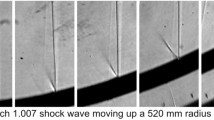Abstract
In the conventional von Neumann theoretical treatment of two-dimensional shock wave reflection off a surface, it is assumed that the flow is inviscid and that the reflecting surface is perfectly smooth, rigid, non-porous, and adiabatic. These theoretical predictions have been found to be good predictions of reflection over a significant range where regular reflection exists and for a limited range around Mach 2 for strong shocks in the case of Mach reflection. However, experiments on regular reflection have shown that this pattern persists to a small extent beyond what the theory predicts. This effect has been ascribed to the development of a viscous boundary layer behind the point of reflection, and some studies have been done on the effect of surface roughness on reflection topology. The possibility of thermal effects and heat transfer from the shock-heated gas to the wall and on the boundary layer has, on the other hand, been almost totally neglected. To study this, two surfaces of different conductivities have been placed at the same angle, symmetrically in a shock tube, and impacted by a single plane shock wave and the reflection patterns examined. Tests were conducted over a range of Mach numbers between 1.28 and 1.4, and incident shock wave angles between \(36^\circ \) and \(70^\circ \) covering both regular and Mach reflection. Both quantitative and qualitative tests show that there is a difference in the angles between the reflected waves and the reflecting surfaces based on the material thermal conductivity. In the quantitative tests the value of this angle was larger for materials with a lower thermal conductivity, and vice versa. A material, such as aluminium, with mid-range thermal conductivity had angles that lay within the limits of the two extreme values for glass and copper. The qualitative images supported these findings, showing asymmetry in reflection topography, with the intersection of the two reflected shock waves lying closer to the material with a higher thermal conductivity.


















Similar content being viewed by others
References
Barbosa F, Skews B (2002) Experimental confirmation of the von Neumann theory of shock wave reflection transition. J Fluid Mech 472:263–282
Ben-Dor G, Mazor G, Takayama K, Igra O (1987) Influence of surface roughness on the transition from regular to Mach reflection in pseudo-steady flows. J Fluid Mech 176:333–356
Henderson LF, Crutchfield WY, Virgona RJ (1997) The effects of thermal conductivity and viscosity of argon on shock waves diffracting over rigid ramps. J Fluid Mech 331:136
Hornung HG, Taylor JR (1982) Transition from regular to Mach reflection of shock waves. J Fluid Mech 123:143–153
Mark H (1958) The interaction of a reflected shock wave with the boundary layer in a shock tube. Tech. rep, NACA TM, p 1418
Rott N, Hartunian RA (1955) On the heat transfer to the walls of a shock tube. Tech. rep., Cornell University, USAF contract AF 33(038)-21406
Skews BW, Berry R, Paton RT (2016) Effect of surface properties on shock wave reflection. In: 12th International conference on heat transfer, fluid mechanics and thermodynamics, HEFAT. ISBN:978-1- 77592-124-0
The Engineering Toolbox (2017) Thermal conductivity of common materials and gases. http://www.EngineeringToolBox.com. Accessed May 2017
van Netten AA, Dewey JM, von Haimberger T (1994) The effects of surface temperature on the shock wave reflection process. In: Proc. 11th Mach reflection symposium, University of Victoria, Canada
von Neumann J (1943) Oblique reflection of shocks. Bur. Ord. Explosives Research Tech, Report, p 12
Acknowledgements
We wish to acknowledge the support of the South African National Research Foundation and the valued assistance of Mr. Paul Sauer and staff at Airbus Defense and Space, Optronics Division for polishing of the test pieces.
Author information
Authors and Affiliations
Corresponding author
Rights and permissions
About this article
Cite this article
Skews, B., Berry, R. Experimental study of wall conductivity influence on shock wave reflection. Exp Fluids 58, 167 (2017). https://doi.org/10.1007/s00348-017-2454-3
Received:
Revised:
Accepted:
Published:
DOI: https://doi.org/10.1007/s00348-017-2454-3



